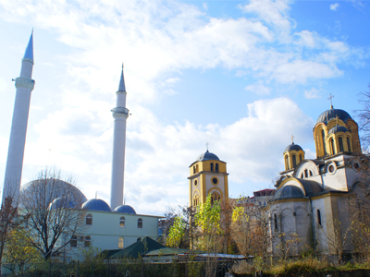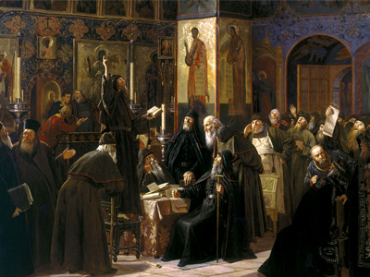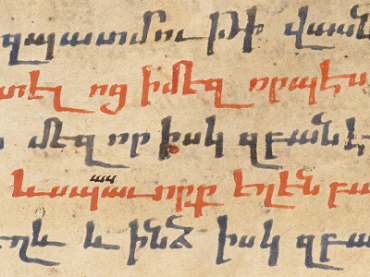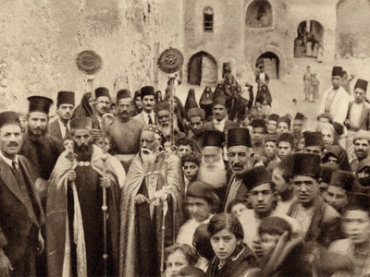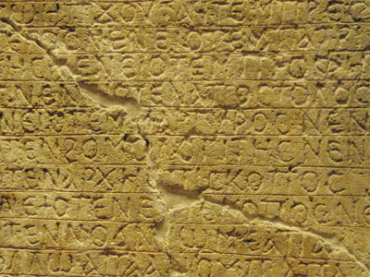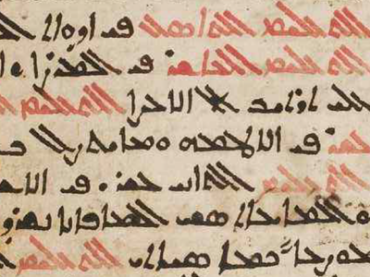Syriac and Eastern Christianity
The Harp (Volume 23)
Series: The Harp 23
ISBN: 978-1-61143-658-7
The Harp is the scholarly journal of Syriac, Oriental, and Ecumenical studies published by the St. Ephrem Ecumenical Research Institute (SEERI) in Kottayam, India.
$186.00
The Harp (Volume 24)
Series: The Harp 24
ISBN: 978-1-61143-659-4
The Harp is the scholarly journal of Syriac, Oriental, and Ecumenical studies published by the St. Ephrem Ecumenical Research Institute (SEERI) in Kottayam, India.
$193.00
The Harp (Volume 25)
Series: The Harp 25
ISBN: 978-1-61143-660-0
The Harp is the scholarly journal of Syriac, Oriental, and Ecumenical studies published by the St. Ephrem Ecumenical Research Institute (SEERI) in Kottayam, India.
$221.00
An Album of Dated Syriac Manuscripts
By William Henry Paine Hatch; With a New Foreword by Lucas Van Rompay
ISBN: 978-1-61143-661-7
The main reference for dating Syriac manuscripts and the standard in the field. This Album conveniently brings together two hundred facsimiles, each representing a page of a dated Syriac manuscript.
$231.00
Journal of the Canadian Society for Syriac Studies 10
Edited by Amir Harrak
ISBN: 978-1-61143-671-6
Volume 10 includes articles by Robert Thomson, Edward G. Mathews Jr., Claude Cox, Hidemi Takahashi and Jos J.S. Weitenberg, and Arman Akopian. It is on Syriac-Armenian topics.
$75.00
`Enbe men Karmo Suryoyo (Bunches of Grapes from the Syriac Vineyard)
A Syriac Chrestomathy
Series: Gorgias Handbooks 6
ISBN: 978-1-61143-685-3
`Enbe men Karmo Suryoyo is a chrestomathy intended primarily for students who have covered the essentials of Syriac morphology and syntax, but it should also interest anyone who enjoys Syriac literature in general. The twenty-six selections consist of examples of Syriac prose and poetry from the second until the thirteenth centuries AD. The readings reflect a wide and varied range of subject matter. Inevitably, selections of a religious nature predominate, but historical, ethnographic, chemical, astronomical, and linguistic excerpts produced by famous Syriac authors, as well as less familiar ones, have been included. A Syriac-English glossary and an index of grammatical points are included.
$58.00
A 16th Century Italo-Byzantine Cross
Edited by Sheila Campbell
Series: Gorgias Eastern Christian Studies 32
ISBN: 978-1-4632-0163-0
The contributors have tried to reconstruct the mingling of two cultures, Greek and Italian, in sixteenth century Venice. This is examined through the medium of a single intricately carved wooden cross, executed by a Greek carver, with adaptations suitable to a member of the Latin church. We can identify the carver who made the cross and make some speculations about his life, and how he and his art are reflective of this hybrid culture. This type of cross seems to be for personal, rather than liturgical use, and it seems to be intended for private meditation on the Passion.
$165.00
Raumdimensionen im Altertum
Edited by Maria Kristina Lahn & Maren-Grischa Schröter
Series: MOSAIK<i>journal</i> 1
ISBN: 978-1-61143-955-7
MOSAIKjournal was established in 2009 as an interdisciplinary e-journal primarily specializing in research on antiquity. Each volume is dedicated to a special topic of current academic interest. The aim of this new journal is to give scholars a joint forum of discussion and to synthesize results of different disciplines.
$153.00
Vie Latine de l’empire Ottoman
Les Latins d'Orient
ISBN: 978-1-61143-721-8
An extensive discussion of the Latin east and the Ottoman Levantines from the fall of Istanbul (ancient Constantinople) in 1453 to the recent past.
$124.00
Familles Latines de l’Empire Ottoman
ISBN: 978-1-61143-722-5
A comprehensive history of the Latins of Asia Minor up to the present day also with discussions on various cultural and social issues such as “identity” and “nation”.
$124.00
Der Psalmencommentar des Theodor von Mopsuestia in syrischer Bearbeitung
Series: Analecta Gorgiana 5
ISBN: 978-1-61143-792-8
Baethgen describes a Syriac text purporting to be a translation of a commentary on the psalms by Theodore of Mopsuestia, showing that it cannot be a simple translation of Theodore's commentary but does contain much material derived from him.
$42.00
The Book of Adam and Eve
A Book of the Early Eastern Church
Translation and Introduction by S. C. Malan
Series: Kiraz Theological Archive 77
ISBN: 978-1-61143-830-7
This work narrates the history of the world from Adam to Jesus, presented in an English translation of Ethiopic and Coptic manuscripts. This exclusive translation of rare sources is recommended for readers interested in comparative religion, Oriental Orthodoxy, and biblical studies.
$182.00
The Armenian Life of Marutha of Maipherkat
Translation and Introduction by Ralph Marcus
Series: Analecta Gorgiana 937
ISBN: 978-1-61143-831-4
This work retells the life of the Bishop Marutha of Maipherkat, or Martyropolis, as translated from the Armenian text.
$36.00
L'Expansion nestorienne en Asie
By François Nau
Series: Kiraz Classic Archaeological Reprints 16
ISBN: 978-1-61143-832-1
This early history of the Church of the East was part of a volume issued to commemorate the exhibition of thirty Syriac inscriptions from Central Asia at the Musee Guimet.
$168.00
The Nestorian Monument in China
Series: Kiraz Chronicles Archive 50
ISBN: 978-1-61143-838-3
The text in Chinese and Syriac, with English translation and notes, of the Nestorian Stele, set up in Changan in 781, with a history of the Nestorian Christians of China and their final state as a secret society.
$203.00
A Ruined Nestorian City in Inner Mongolia
Series: Analecta Gorgiana 954
ISBN: 978-1-61143-871-0
Owen Lattimore, a historian of Central Asia, presents the first report on Kwei-hua, the ruined city of the Syriac-Ongut Turks.
$35.00
An Eastern Embassy to Europe in the Years 1287-8
Series: Analecta Gorgiana 957
ISBN: 978-1-61143-874-1
Rabban Sauma, a Syriac monk, travelled to Europe in 1287 as a diplomatic representative of the Mongols; this is his own account of his travels, the first translation into English.
$35.00
Hugoye - Journal of Syriac Studies (volume 14)
2011
General Editor George Anton Kiraz
Series: Hugoye: Journal of Syriac Studies 14
ISBN: 978-1-61143-926-7
Widely regarded as a premier journal dedicated to the study of Syriac, Hugoye: Journal of Syriac Studies was established in 1998 as a venue devoted exclusively to the discipline. An organ of Beth Mardutho, the Syriac Institute, the journal appears semi-annually and will be printed in annual editions. A peer-reviewed journal, Hugoye is a respected academic source for up-to-date information about the state of Syriac studies and for discovering what is going on in the field. Contributors include some of the most respected names in the world of Syriac today.
$75.00
On the Nestorian Tablet of Se-gan Foo
Series: Analecta Gorgiana 985
ISBN: 978-1-61143-922-9
This work contains a full description of the Nestorian Stone in English.
$45.00
The Scope and Contents of Chingis Khan's Yasa
Series: Analecta Gorgiana 986
ISBN: 978-1-61143-923-6
Genghis Khan's law code, the Yasa, survives in fragments. This article lists the known provisions, from Berhebraeus, Juwaini, and Arab sources; Vernadsky considers it a supplement to Mongol custom for the multinational Empire.
$36.00
Les lectionnaires de l’ancienne liturgie de Jérusalem
Series: Analecta Gorgiana 1009
ISBN: 978-1-61143-998-4
An extract from Collectanea Christiana Orientalia (2005)
$35.00
La Mas’alat al-kana’is de Ibn Taymiyya
Series: Analecta Gorgiana 1031
ISBN: 978-1-4632-0020-6
An extract from Collectanea Christiana Orientalia (2008)
$39.00
Coptic Loanwords of Egyptian Arabic in Comparison with the Parallel Case of Romance Loanwords in And
Series: Analecta Gorgiana 1038
ISBN: 978-1-4632-0027-5
An extract from Collectanea Christiana Orientalia (2008)
$46.00
The Sacrament of Holy Baptism
According to the Ancient Rite of the Syrian Orthodox Church of Antioch
Translated by Murad Barsom; Edited by Mor Athanasius Yeshue Samuel
Series: Syriac Liturgies for Worship 4
ISBN: 978-1-61143-958-8
A bilingual edition (Syriac and English) of the service of baptism as used by the Syriac Orthodox Church today.
$149.00
The Order of Solemnization of the Sacrament of Matrimony
According to the Ancient Rite of the Syrian Orthodox Church of Antioch
Translated by Murad Barsom; Edited by Mor Athanasius Yeshue Samuel
Series: Syriac Liturgies for Worship 5
ISBN: 978-1-61143-959-5
A bilingual edition (Syriac and English) of the service of matrimony as used by the Syriac Orthodox Church today.
$148.00
Filter by
Filter by price
Filter by manufacturer

